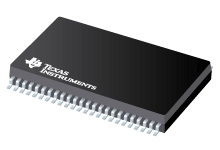Datasheet Texas Instruments SN65LVDS386DGG — Ficha de datos
| Fabricante | Texas Instruments |
| Serie | SN65LVDS386 |
| Numero de parte | SN65LVDS386DGG |

Receptor LVDS de 16 canales 64-TSSOP -40 a 85
Hojas de datos
High-Speed Differential Line Receivers. datasheet
PDF, 1.7 Mb, Revisión: I, Archivo publicado: jul 29, 2014
Extracto del documento
Precios
Estado
| Estado del ciclo de vida | Activo (Recomendado para nuevos diseños) |
| Disponibilidad de muestra del fabricante | No |
Embalaje
| Pin | 64 |
| Package Type | DGG |
| Industry STD Term | TSSOP |
| JEDEC Code | R-PDSO-G |
| Package QTY | 25 |
| Carrier | TUBE |
| Device Marking | LVDS386 |
| Width (mm) | 6.1 |
| Length (mm) | 17 |
| Thickness (mm) | 1.15 |
| Pitch (mm) | .5 |
| Max Height (mm) | 1.2 |
| Mechanical Data | Descargar |
Paramétricos
| Device Type | Receiver |
| ESD HBM | 15 kV |
| Function | Receiver |
| ICC(Max) | 70 mA |
| Input Signal | LVDS |
| No. of Rx | 16 |
| Operating Temperature Range | -40 to 85 C |
| Output Signal | LVTTL |
| Package Group | TSSOP |
| Package Size: mm2:W x L | 64TSSOP: 138 mm2: 8.1 x 17(TSSOP) PKG |
| Protocols | LVDS |
| Signaling Rate | 250 Mbps |
Plan ecológico
| RoHS | Obediente |
Kits de diseño y Módulos de evaluación
- Evaluation Modules & Boards: SN65LVDS386EVM
16-channel LVDS Receiver Evaluation Module
Estado del ciclo de vida: Activo (Recomendado para nuevos diseños)
Notas de aplicación
- Using Signaling Rate and Transfer Rate (Rev. A)PDF, 258 Kb, Revisión: A, Archivo publicado: feb 7, 2005
This document defines data signaling rate and data transfer rate, and it demonstrates the differences between them. Taking the SN65LVDS386 and SN65LVDS387 16-channellow-voltage differential (LVDS) line drivers and receivers with random parallel data of various bandwidths as an example, this document discusses the components that make up the system timing budget and presents empirical data on cro
Linea modelo
Serie: SN65LVDS386 (4)
- SN65LVDS386DGG SN65LVDS386DGGG4 SN65LVDS386DGGR SN65LVDS386DGGRG4
Clasificación del fabricante
- Semiconductors > Interface > LVDS/M-LVDS/PECL > Buffers, Drivers/Receivers and Cross-Points